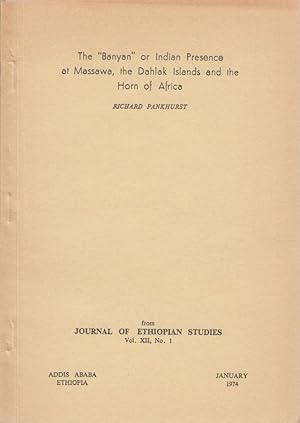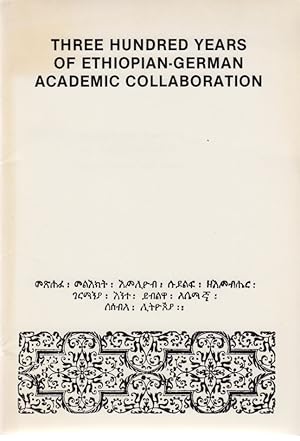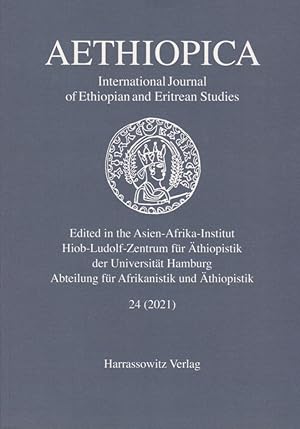Fundus-Online GbR Borkert Schwarz Zerfaß (8 Ergebnisse)
Produktart
- Alle Product Types
- Bücher (8)
- Magazine & Zeitschriften
- Comics
- Noten
- Kunst, Grafik & Poster
- Fotografien
- Karten
- Manuskripte & Papierantiquitäten
Zustand
- Alle
- Neu
- Antiquarisch (8)
Einband
Weitere Eigenschaften
- Erstausgabe
- Signiert (1)
- Schutzumschlag
- Angebotsfoto (8)
- Keine Print-on-Demand Angebote (8)
Gratisversand
- Versand nach gratis
Land des Verkäufers
Verkäuferbewertung
-
The "Banyan" or Indian Presence at Massawa, the Dahlak Islands and the Horn of Africa. [From: Journal of Ethiopian Studies, Vol. 12, No. 1, January 1974].
Verlag: Addis Ababa, 1974
Anbieter: Fundus-Online GbR Borkert Schwarz Zerfaß, Berlin, Deutschland
Buch
Reprint, stapled. Zustand: Gut. p. 185-212. Binding a bit light-margined, paper browned, otherwise good and very clean. - From the text: THE EARLIER HISTORICAL SETTING. An Indian commercial presence in the area of the Gulf of Aden, including the Gulf of Aden and Red Sea coasts of Africa, can be discerned from very early times. Tradition, later recorded by the Arab historian Masudi, relates that in the fourth century B. C. the Greek philosopher Aristotle wrote to Alexander the Great at the time of the latter's expedition to the East, giving him information on the island, and proposing the establishment there of a colony of Greeks. Alexander, it is said, accordingly despatched a certain number of Greeks, as a result of which "they subdued the Indians who were established there, took possession of Sokotra and removed a colossal idol to which the Indians paid homage." Support for Masudi's story of this early Indian presence on the island is afforded by Diodorus of Sicily who stated in the first century B. C. that the island of Panchaea, generally identified as Sokotra, had a foreign population of "Oceanites and Indians and Scythians and Cretans," and that the islands called fortunate, another apparent reference to Sokotra, were "frequented by merchants who come there from all parts, and principally from Potana, the town which Alexander had built on the bank of the Indus river." Such references are further confirmed in the Periplus of the Erythraean Sea, a work of the first century or so of the Christian era, which reports that the island's population included "a mixture of Arabs, Indians and Greeks who have emigrated to carry on trade there." Sprache: Englisch Gewicht in Gramm: 550.
Bestandsnummer des Verkäufers 1219157
-
Äthiopien. Texte und Fragen. Studienheft 11.
Verlag: Hamburg: Missionshilfe Verlag, 1980
ISBN 10: 3921620139ISBN 13: 9783921620137
Anbieter: Fundus-Online GbR Borkert Schwarz Zerfaß, Berlin, Deutschland
Buch
Originalbroschur. Zustand: Gut. 80 S., zahlr. Abb. Etwas lichtrandig, sonst sauber. - Inhalt: Grunddaten -- Zeittafel -- Missionshandwerker gesucht -- Die Orthodoxe Kirche Äthiopiens in ihrer Geschichte -- Die Christliche Kunst Äthiopiens -- Haile Selassie I. -- Vom Kaiserreich zur Revolution -- Kirche und Revolution -- Die kritische Lage der Orthodoxie heute -- Missionarische Beziehungen heute -- .Nicht für sich selbst, GudinaTumsa -- Die Versorgungs- und Aufgabenstrukturder Ethiopian Evangelical Church Mekane Yesus -- Die Auswirkungen der Landreform auf die Kirche -- Kirchliche Entwicklungsarbeit -- Das Schulwesen in Äthiopien -- Der Islam in Äthiopien -- Nationalitäten in Äthiopien -- Der Konflikt in Eritrea -- Menschenrechtsprobleme in Äthiopien - Literatur. ISBN 3921620139 Sprache: Deutsch Gewicht in Gramm: 550.
Bestandsnummer des Verkäufers 1192873
-
Sozio-Kultur und Entwicklungspraxis : die äthiopische staatliche Hochschulreform. Europäische Hochschulschriften / Reihe 22 / Soziologie ; Bd. 455
Verlag: Frankfurt, M. : PL Acad. Research, 2014
ISBN 10: 363165023XISBN 13: 9783631650233
Anbieter: Fundus-Online GbR Borkert Schwarz Zerfaß, Berlin, Deutschland
Buch
kart. Zustand: Sehr gut. IX, 136 S. : graph. Darst. ; 21 cm Tadelloses Exemplar. - Inhaltsverzeichnis -- Vorwort vii -- Einleitung 1 -- 1. Die äthiopische staatliche Hochschulreform 5 -- 1.1 Adama University 5 -- 1.2 Framework. 8 -- 1.3 School of Humanities & Natural Sciences 11 -- 1.4 Zwischenbilanz 13 -- 2. Exkurs: Pädagogisches Erbe, Modernisierungsdoktrin -- und Bildungshilfe 15 -- 2.1 Charakteristika der äthiopischen Bildungslandschaft nach 1941 15 -- 2.2 Zur aktuellen Hochschulpolitik Äthiopiens 21 -- 2.3 Modernisierungsdoktrin und Kulturrelativismus 26 -- 3. Grenzen der Machbarkeit 33 -- 3.1 Adama University: Eine Bilanz 33 -- 3.2 Sozio-kulturelle Determinanten in der Entwicklungstheorie 36 -- 3.3 Selektive Typologie: Zeit, Klientel, Sprache 45 -- 3.3.1 Zeit 45 -- 3.3.2 Klientelismus 50 -- 3.3.3 Sprache 56 -- 4. Die sozio-kulturellen Schlüsselfaktoren des BMZ in -- der Entwicklungspraxis 65 -- Schlussfolgerungen 71 -- Literaturverzeichnis 77 -- Anhang 81 -- Continuing Professional Development for Higher Education -- Institutions In Ethiopia: The Framework 83 -- Abstract 136 ISBN 9783631650233 Sprache: Deutsch Gewicht in Gramm: 198.
Bestandsnummer des Verkäufers 1085934
-
Three Hundred Years of Ethiopian-German Academic Collaboration. Sonderschriften des Frobenius-Instituts, 2. / Katalog zu einer Ausstellung des Frobenius-Instituts im Goethe-Institut Addis Ababa.
Verlag: Wiesbaden: Franz Steiner, 1986
Anbieter: Fundus-Online GbR Borkert Schwarz Zerfaß, Berlin, Deutschland
Buch Signiert
Original brochure, stapled. Zustand: Gut. 37 p., num. fig. Enclosed business card with dedication by Eike Haberland. - Binding little light edged, otherwise good and very clean. - From the text: This booklet is intended to draw attention to an aspect of Ethiopian studies which is almost always overlooked the collaboration between people of two nations. In this context, many questions apparently remain open. How, for example, did famous books come into existence? With whom did the authors actually speak? Who were their friends and collaborators? Were they merely »informants« or true partners? The other side of this coin is the impression that Ethiopia's closed society often takes hardly any notice of a stranger: he is received with hospitality, people are eager to answer his questions or collaborate with him be it in Ethiopia or in Germany but does he leave behind any lasting trace? »Ships that pass in the night«? - Wikipedia: Eike Friedrich Georg Haberland (* 18. Mai 1924 in Detmold; 6. Juni 1992 in Frankfurt am Main) war ein deutscher Ethnologe. Sprache: Deutsch Gewicht in Gramm: 550.
Bestandsnummer des Verkäufers 1192874
-
Der Weg zum Frieden in Äthiopien: Konsens- und Kompromißbildung als Bewältigungsmechanismus soziokultureller, wirtschaftlicher und geopolitischer Konflikte in Äthiopien. Ein Versuch, ethnische Politik nach Grundlagen sozialphilosophischer Ideen Jürgen Habermas' abzuhandeln.
Verlag: Leipzig: Universität, 1996
Anbieter: Fundus-Online GbR Borkert Schwarz Zerfaß, Berlin, Deutschland
Buch
Typoskript. Zustand: Gut. 59 S. Ein tadelloses Exemplar. - Aus dem Text: Die Lage in vielen afrikanischen Nationalstaaten ist heute durch ethnische Konflikte und Bürgerkriege gekennzeichnet. Man kann die politische Situation in Somalia, Ruanda, Liberia, Zaire u.a. als Beispiele nennen. Folgende Punkte erscheinen mir, bewegende Fragen in Afrika zu sein. (a) Die Tatsache, dass die andere in den Busch rennt, wenn eine Partei in vielen multiethnischen Ländern Afrikas die Staats-macht übernimmt - d.h. der Bürgerkrieg als menschliche Tragö-die. (b) Rebellen in Afrika haben eigentlich keine Waffenindustrie selbst. Worin besteht das, dass die Rebellen auch fast genauso wie die Truppen der Regierung bewaffnet sind? Ist es schwierig für die Gesellschaften in der postkonventionalen Stufe der Moralentwicklung, ihr moralisches Bewußtsein die Ozeane überqueren zu lassen, um bei der Lösung afrikanischer Konflikte tatsächlich Maßnahmen zu entwickeln und systematisch durchzusetzen, ohne dass sie sich tief in die inneren Angelegenheiten der afrikanischen Staaten einmischen? (c) Überläßt die Weltgemeinschaft alles nur den afrikanischen Staaten, ist es unmöglich, Demokratisierungsprozesse in Schwarzafrika weiterzutreiben. (d) Viele Normen und Werte in Afrika wirken gegen die mögliche Demokratisierung. Sie so zu lassen, wie sie jetzt ist, bedeutet keine Aufklärung; keine Aufklärung bedeutet keine Rationalisierung und Säkularisierung der Gesellschaft. Sie einfach durch staatliche Macht, etc, für nichts zu erklären oder sie zu ignorieren, kann auch viele andere Probleme hervorrufen, die Sicherheit und Ordnung in diesem Teil unseres Planeten mehr verschlechtern können. (e) Die Konkurrenzfähigkeit der Dritten Welt im Weltmarkt ist sehr gering, weil sie meist Rohstoffe oder landwirtschaftliche Produkte exportieren. (f) Hört die Dritte Welt mit diesen ungleichen Verhältnissen am Weltmarkt auf, ist sie nicht in der Lage, in der heute auf verschiedenen Ebenen miteinander verflochtenen internationalen Beziehungen zu überleben. Sprache: Deutsch Gewicht in Gramm: 550.
Bestandsnummer des Verkäufers 1235670
-
Industrial clustering, firm performance and employee welfare. Evidence from the shoe and flower cluster in Ethiopia. / Development economics and policy ; vol. 75.
Verlag: Frankfurt am Main : Peter Lang, 2016
ISBN 10: 3631667442ISBN 13: 9783631667446
Anbieter: Fundus-Online GbR Borkert Schwarz Zerfaß, Berlin, Deutschland
Buch
Originalhardcover. Zustand: Sehr gut. 235 S., Abb. Ein tadelloses Exemplar. - The author examines the productivity, profitability and welfare effects of industrial clustering and a public policy promoting industrial clusters in Ethiopia. He uses reliable counterfactuals as well as original enterprise and worker level data. By investigating the effect of firm, time, entrepreneur and site specific factors as well as endogenous location choice issues, the author finds strong evidence for the existence of significant agglomeration economies in the Ethiopia leather footwear cluster. Using primary survey data collected from firms which benefited from the cluster policy and those that did not, both before and after the implementation of the policy, the author shows the unintended negative impact of a cluster prompting policy in Ethiopia. The book is essential reading for those who are interested in the gender and welfare impact of female full time labor force participation in industrial jobs. ISBN 9783631667446 Sprache: Englisch Gewicht in Gramm: 408.
Bestandsnummer des Verkäufers 1146720
-
Aethiopica 24 ( 2021 ) : International Journal of Ethiopian and Eritrean Studies. Aethiopica ; 24.
Verlag: Wiesbaden : Harrassowitz Verlag. Erscheinungstermin: Februar 2022., 2022
ISBN 10: 3447181311ISBN 13: 9783447181310
Anbieter: Fundus-Online GbR Borkert Schwarz Zerfaß, Berlin, Deutschland
Buch
Broschiert. Zustand: Gut. 310 Seiten : 15 fig., 6 tables ; 24 cm x 17 cm, 585 g sehr guter Zustand / neuwertig - Aethiopica is an internationally refereed academic journal, edited at the Hiob Ludolf Centre for Ethiopian Studies and at the Department of African and Ethiopian Studies of the Asien-Afrika-Institut at the University of Hamburg. It is published annually in a printed version. The journal focuses on philology, linguistics, archaeology, history, cultural anthropology, religion, philosophy, literature, and manuscript studies, with a regional emphasis on Eritrea, Ethiopia, the Horn of Africa, and related areas. The journal welcomes contributions on relevant academic topics as well as on recent research in the respective fields. Each issue of Aethiopica contains reviews of books which form a substantial section of the journal. Aethiopica is published mainly in English. Articles in French, German and Italian are also accepted for publication. An English abstract for all articles in any language is provided. - Table of Contents -- Editorial -- Articles -- GETATCHEW HAILE, Conversation of Our Lord and Saviour Jesus with His Twelve Apostle Disciples at Jericho ( EMML 7229, fols 93r-109r ) -- MASSIMO VILLA, Multiple-Text Manuscripts from the Gondarine Age: MSS BL Or. 818 and BnF Éthiopien 146 -- ZAROUI POGOSSIAN, Armeno-Aethiopica in the Middle Ages: Geography, Tales of Christianization, Calendars, and Anti-Dyophysite Polemics in the First Millennium -- MASSIMO ZACCARIA, From Incunabula to Book History: Ethiopia, Eritrea, and the Search for their Printed Past -- NAFISA VALIEVA and PIETRO MARIA LIUZZO, Giving Depth to TEl-Based Descriptions of Manuscripts: The Golden Gospel of Ham -- MARIA BULAKH, MAGDALENA KRZYZANOWSKA, and FRANCESCA PANINI, Bibliography of Ethiopian Semitic, Cushitic, and Omotic Linguistics XXIV: 2020 -- Aethiopica 24 ( 2021 ) . ISBN 9783447181310 Sprache: Englisch Gewicht in Gramm: 580.
Bestandsnummer des Verkäufers 1207843
-
Die verborgene Wirklichkeit: Drei äthiopische Maler der Gegenwart ; Zerihun Yetmgeta, Girmay Hiwet, Worku Goshu. Ausstellung, Völkerkundemuseum der Universität Zürich, 20. September 1989 - 7. Januar 1990.
Verlag: Zürich : Völkerkundemuseum der Universität Zürich., 1989
ISBN 10: 3909105114ISBN 13: 9783909105113
Anbieter: Fundus-Online GbR Borkert Schwarz Zerfaß, Berlin, Deutschland
Buch
Broschiert / Paperback. Zustand: Gut. 214 S., Abb.; 21 cm Aus der Arbeitsbibliothek von Hans-Joachim Koloss, Kurator der Afrika-Abteilung des Museums für Völkerkunde Berlin. / From the working library of Hans-Joachim Koloss, curator of the African department of the Berlin Ethnography Museum. - Cover leicht lichtverändert gebräunt, ansonsten tadelloser Zustand / Cover slightly light browned, otherwise perfect condition - Deutsch / Englisch: Vorwort -- Preface -- Die Ausstellung «Die verborgene Wirklichkeit» erhebt keineswegs den Anspruch, einen repräsentativen Überblick über die äthiopische zeitgenössische Malerei zu geben, denn da hätten viel mehr Künstler einbezogen werden müssen. Bei der Auswahl war wichtig, dass die Maler einen eher abstrahierenden Malstil pflegen und dass neben dem in der Schweiz lebenden Maler Girmay Hiwet auch Künstler vertreten sind, die in Äthiopien arbeiten. -- Mit Zerihun Yetmgeta und Girmay Hiwet werden zwei Maler vorgestellt, die sich in vielen ihrer Werke von der Vorstellungswelt der äthiopischen Völker, von alten Zeiten sowie von der geometrischen und insbesondere von der magischen Kunst inspirieren lassen, wobei Girmay Hiwet die Motive stärker abstrahiert als Zerihun Yetmgeta; vor allem in den Werken des letzteren findet sich auch eine intensive Auseinandersetzung mit schwarz-afrikanischer Kunst. Viele von Worku Goshu's Arbeiten sind von christlichen Themen beeinflusst. Andere setzen sich in expressionistischer Weise mit dem Menschen und seinen Gefühlen auseinander. Stilistisch -- -- orientieren sich diese Arbeiten weniger an der äthiopischen traditionellen Kunst, so dass sie einen eigentlichen Kontrast zu den Werken der beiden anderen Künstler bilden. Gemeinsam ist allen drei Malern, dass sie sich auch aktiv mit aktuellen Problemen nicht nur Äthiopiens, sondern der Welt im allgemeinen auseinandersetzen. -- Im Katalog habe ich versucht, auf den kulturellen Hintergrund, der die Maler geprägt hat, so weit einzugehen, als dies zum Verständnis ihrer Werke notwendig scheint. Darüber hinaus wird ein kurzer Überblick über die traditionelle und die zeitgenössische Malerei bis in die jüngste Gegenwart vermittelt, ebenso ein geschichtlicher Überblick, der das Verständnis der Entwicklungsgeschichte der äthiopischen Malerei erleichtern soll. -- Zum Konzept der Ausstellung gehört, dass sich die Künstler so vorstellen, wie es ihren eigenen Wünschen entspricht, d.h., dass sie die Bilder für die Ausstellung weitgehend selber auswählten und dass im Katalog vor allem ihre eigenen Aussagen zu den Bildern wiedergegeben werden; dort, wo es mir nötig schien, habe ich den kulturellen Kontext erläutert. Girmay Hiwet hat mir seine Werke in zahlreichen Gesprächen erklärt, bei denen ich Notizen zu machen pflegte; bei Zerihun Yetmgeta benutzte ich den Kassettenrekorder. Worku Goshu hingegen war der Ansicht, dass seine Bilder für sich selber sprechen. So sind auch die Kapitel über die Künstler recht unterschiedlich geworden, und in jedem habe ich versucht, etwas von der Art und Weise, wie sich die Maler selber sehen und darstellen, einzubringen. -- Auf kunsthistorische Analysen und Stilvergleiche habe ich als Ethnologin weitgehend verzichtet. Eine diesbezügliche eingehende Analyse wäre allerdings wünschenswert. -- The exhibition «The hidden reality» does not claim in any way to give a representative survey of Ethiopian contemporary painting, for in that case, many more artists would have had to be included. In the selection it was important that the painters cultivate a rather abstract style of painting, and that in addition to the painter Girmay Hiwet, who lives in Switzerland, other painters working in Ethiopia should also be represented here. -- Zerihun Yetmgeta and Girmay Hiwet are two painters who are inspired in their work by the concepts of the different Ethiopian peoples; by old times as well as by the geometric and particularly, by the magical art; Girmay Hiwet abstracts the motifs more than Zerihun Yetmgeta; the latter especially deals in his work intensively with Black African art. Many of Worku Goshu's paintings are influenced by Christian subjectmatters. Others deal with human beings and feelings in an expressionistic way. These works are stylistically less oriented to the Ethiopian traditional art; therefore, they build a real contrast to the work of the other two artists. All three, however, are actively concerned about actual problems, not only in Ethiopia, but in the world in general. -- In the catalogue, I have tried to go into the artists' cultural background as far as necessary, in order to facilitate the understanding of their works. Additionally, a brief survey will be given about traditional and contemporary art until the present time; a historical review should also make it easy to understand the history of the development of Ethiopian painting. -- The artists introduce themselves in accordance to their own wishes i.e. they were the ones who largely selected the paintings to be shown at the exhibition; in the catalogue, they make their own statements about the paintings - all this belongs to the concept of the exhibition. Wherever necessary, I have added explanations about the cultural context. Girmay Hiwet explained his work to me in several talks we had together and I managed to take notes on these occasions; I recorded the conversations with Zerihun Yetmgeta on tape. Worku Goshu's opinion, however, was, that his paintings speak for themselves. -- Thus, the chapters on the artists have turned out to be quite distinct; each chapter attempts to include something about the way in which the artists see and portray themselves. -- As an ethnologist I have refrained largely from making art-historical analyses and comparison of styles. A thorough analysis in this connection would of course be desirable. -- Elisabeth Biasio Konservatorin. ISBN 9783909105113 Sprache: Deutsch Gewicht in Gramm: 550.
Bestandsnummer des Verkäufers 1205339









